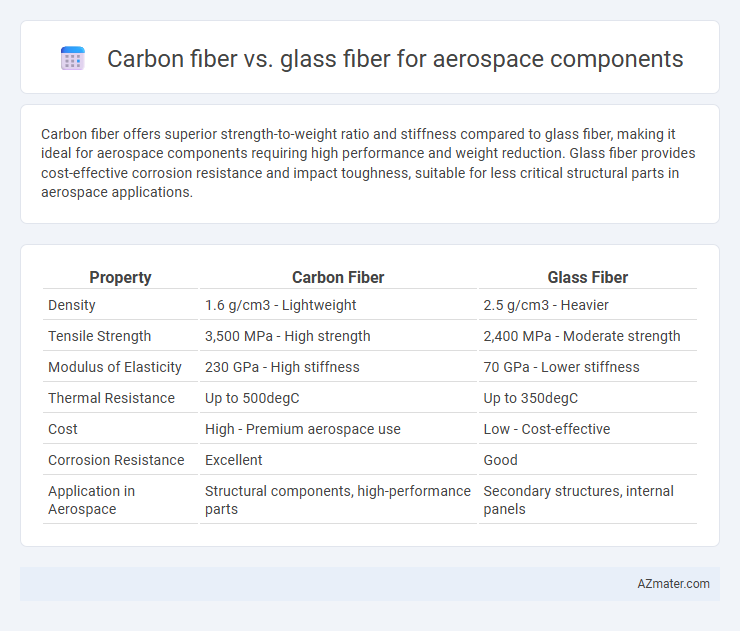Carbon fiber offers superior strength-to-weight ratio and stiffness compared to glass fiber, making it ideal for aerospace components requiring high performance and weight reduction. Glass fiber provides cost-effective corrosion resistance and impact toughness, suitable for less critical structural parts in aerospace applications.
Table of Comparison
| Property | Carbon Fiber | Glass Fiber |
|---|---|---|
| Density | 1.6 g/cm3 - Lightweight | 2.5 g/cm3 - Heavier |
| Tensile Strength | 3,500 MPa - High strength | 2,400 MPa - Moderate strength |
| Modulus of Elasticity | 230 GPa - High stiffness | 70 GPa - Lower stiffness |
| Thermal Resistance | Up to 500degC | Up to 350degC |
| Cost | High - Premium aerospace use | Low - Cost-effective |
| Corrosion Resistance | Excellent | Good |
| Application in Aerospace | Structural components, high-performance parts | Secondary structures, internal panels |
Overview of Composite Materials in Aerospace
Carbon fiber composites offer superior strength-to-weight ratios and stiffness compared to glass fiber, making them the preferred choice for critical aerospace components subject to high stress and performance demands. Glass fiber composites provide cost-effective solutions with good tensile strength and corrosion resistance, often used in non-structural parts and secondary applications. Both materials contribute to weight reduction and fuel efficiency improvements in aerospace engineering by enabling complex, lightweight designs with tailored mechanical properties.
Key Properties of Carbon Fiber
Carbon fiber offers superior strength-to-weight ratio, high stiffness, and excellent fatigue resistance, making it ideal for aerospace components requiring lightweight durability. Its low thermal expansion enhances dimensional stability under varying temperatures, crucial for maintaining structural integrity during flight. Compared to glass fiber, carbon fiber provides enhanced tensile strength and higher modulus, significantly improving performance in critical aerospace applications.
Key Properties of Glass Fiber
Glass fiber offers excellent tensile strength and high resistance to corrosion, making it highly durable for aerospace applications. Its lower density compared to metals contributes to lightweight structural components while maintaining adequate stiffness. Glass fiber's cost-effectiveness and good electrical insulation properties enhance its suitability for aerospace interiors and secondary structures.
Strength-to-Weight Ratio Comparison
Carbon fiber exhibits a superior strength-to-weight ratio compared to glass fiber, making it the preferred material for aerospace components requiring high performance and weight efficiency. The tensile strength of carbon fiber ranges from 3,500 to 6,000 MPa with a density of about 1.6 g/cm3, whereas glass fiber offers tensile strength between 2,000 to 3,500 MPa and a density of approximately 2.5 g/cm3. This significant difference enables carbon fiber to enhance structural integrity while reducing overall aircraft weight, leading to improved fuel efficiency and flight performance.
Durability and Fatigue Resistance
Carbon fiber composites exhibit superior durability and fatigue resistance compared to glass fiber, making them the preferred choice for aerospace components subjected to high cyclic loads. The exceptional tensile strength and stiffness of carbon fiber enhance structural integrity under repeated stress, reducing the risk of crack initiation and propagation. In contrast, glass fiber composites offer lower fatigue resistance and tend to degrade faster in harsh aerospace environments, limiting their long-term performance.
Cost Analysis: Carbon Fiber vs Glass Fiber
Carbon fiber offers superior strength-to-weight ratio and durability but comes at a significantly higher cost compared to glass fiber, making it a premium choice for aerospace components where performance justifies expense. Glass fiber provides a more cost-effective solution with adequate strength and corrosion resistance, preferred in budget-sensitive aerospace applications. Analyzing lifecycle cost, carbon fiber's longer service life and lower maintenance can offset initial price differences in high-performance aerospace structures.
Manufacturing and Processing Differences
Carbon fiber offers superior strength-to-weight ratio and stiffness compared to glass fiber, making it ideal for aerospace components requiring high performance and durability. Manufacturing carbon fiber involves energy-intensive processes like high-temperature carbonization and precise curing cycles, whereas glass fiber production relies on melting silica and forming fibers through a less complex drawing process. Processing carbon fiber typically demands advanced handling techniques to maintain fiber alignment and avoid defects, while glass fiber provides more flexibility and lower material costs but at the expense of weight and mechanical properties.
Performance in Aerospace Environments
Carbon fiber offers superior strength-to-weight ratio and stiffness compared to glass fiber, making it ideal for aerospace components subjected to high stress and dynamic loads. Its excellent fatigue resistance and thermal stability ensure reliable performance in extreme temperature fluctuations and harsh aerospace environments. Glass fiber, while more cost-effective, provides lower mechanical properties and is less suited for critical aerospace applications demanding high performance and durability.
Sustainability and Recyclability
Carbon fiber offers high strength-to-weight ratio and durability, making it ideal for aerospace components while presenting challenges in recyclability due to complex resin matrices. Glass fiber, though heavier and less robust, provides better recyclability and lower environmental impact during production and disposal stages. Sustainable aerospace design increasingly explores hybrid composites and advanced recycling methods to balance performance with environmental responsibility.
Choosing the Right Fiber for Aerospace Applications
Carbon fiber offers superior strength-to-weight ratio and stiffness compared to glass fiber, making it ideal for high-performance aerospace components where weight reduction and structural integrity are critical. Glass fiber is more cost-effective and provides excellent corrosion resistance, suitable for less load-intensive parts or secondary structures in aerospace applications. Selecting the right fiber depends on balancing performance requirements, cost constraints, and environmental exposure specific to the component's function and location within the aircraft.

Infographic: Carbon fiber vs Glass fiber for Aerospace component
 azmater.com
azmater.com